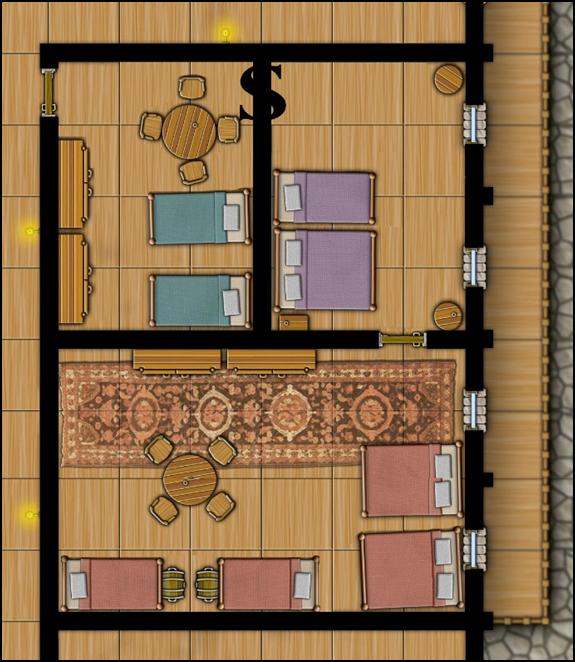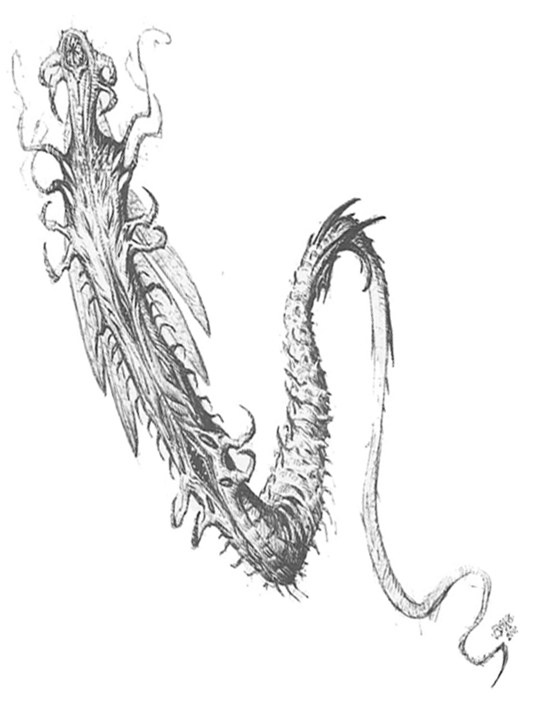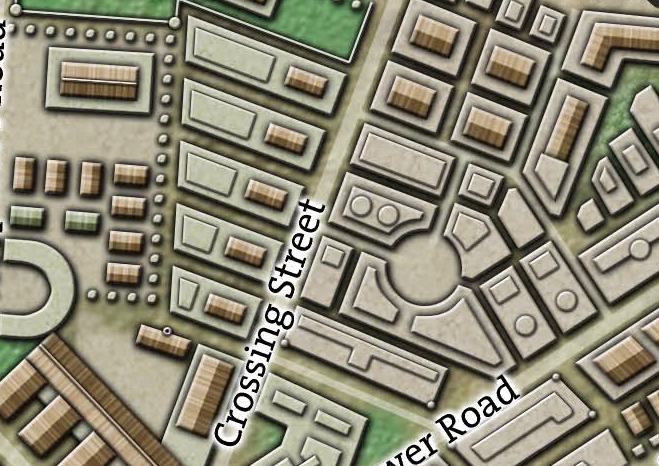
SESSION 47C: HOME SUITE HOME
December 26th, 2009
The 25th Day of Kadal in the 790th Year of the Seyrunian Dynasty
They started towards the Temple District with the crates, intending to dispose of the chaositech as quickly as possible. But on the way, Ranthir convinced the others to let him take the crates back to the Ghostly Minstrel so that he could study them: He was fascinated by what he had read of the technomantic arts of chaositech in some of the lorebooks they had recovered from the cultists and wanted to apply those skills with actual examples of the same. Moreover, even if the material proved useless to them (due to its taint), knowing exactly what these items were capable of might give them some clue as to how the cultists had intended to use them.
When they returned to the Ghostly Minstrel, they found that their new suite of rooms was almost finished: The window wards hadn’t been raised, the secret door leading from the false front room to their actual quarters wasn’t completed, and the reinforced inner door between their quarters wasn’t installed yet, but the rooms themselves were livable and it was clear the work would be easily finished on the morrow.
Ranthir set up his research area in the outer room of the suite (with Tee sleeping on a nearby bed to help keep a watch on the crates). Agnarr, for similar reasons, took Seeaeti to one of the beds in the next room. The others, however, scattered to their old rooms.
Ranthir used several spells to examine the various items in the crates, trying to intuit their purpose. He succeeded with none of them, although he was able to determine that the filigreed manacles could be activated by stroking the oblong device attached to them and the small silver balls could be twisted around their circumference. He also recognized the cord-and-plug attached to the noduled harness as being similar to the one they had found plugged into Shilukar’s neck, suggesting some sort of physio-mental control.
He also discovered, much to his own disquiet, that the floating brain would follow the person closest to it. (On the other hand, it seemed harmless.)
THE SPINESEEKER
Several hours into Ranthir’s candlelit researches, something sinister slithered under the door. Ranthir, intent on the strange intricacies of technomancy, noticed it not as it slipped across the room and attached itself to Tee.
Its first touch was so gentle that Tee didn’t even feel it. And when its voracious, lamprey-like mouths fastened onto multiple points along her spine it was too late… it had taken control of her body. As it drained her lifeblood, she twitched violently on the bed.
Ranthir, unfortunately, remained oblivious.
Tee, waking to find herself trapped in what felt like an endless life-or-death struggle for the control of her own body, felt the creature take her to the very cusp of death before she finally managed to seize a moment of self-control.
“It’s biting me! On the back of my neck! It’s controlling me and I don’t—“
The creature re-asserted its vice-like grip over her body. Tee’s mouth snapped shut.
Ranthir called out for Agnarr while backing nervously away from Tee, who rose from the bed and headed towards the door. Agnarr snorted himself awake and came into the outer room. “What’s wrong?”
“Tee’s acting strangely.”
By this time Tee had reached the door. As she opened it, Agnarr crossed to her. “Tee? What’s wrong?”
Tee smiled up at him. “Nothing’s wrong.”
But something was definitely wrong… She was being way too nice to Agnarr.
Agnarr shared a moment of befuddlement with Ranthir as Tee turned and walked out the door. Ranthir, at a loss for anything else to do, cast a web into the hall – filling it from side-to-side and stopping her from leaving.
But Tee’s reflexes seemed undimmed by her possession. She lithely avoided the worst of the webs and started making her way determinedly through the rest of them. Halfway through the process, however, she managed to wrench control away from the spineseeking demonic worm on her back a second time: “It’s on my back! It’s taken control of my mind! Help me!”
Agnarr, finally figuring out exactly what was happening (and perhaps truly waking up for the first time), used his flaming greatsword to rapidly burn his way through the web towards her.
As the thing tried to regain its control over Tee, Tee reached up, grabbed ahold of its slippery length, and tore it free. She got her first true look at the gruesome creature: A snake-like body covered with the chitinous hide of a scorpion; hundreds of skittering, insectoid legs; and three lamprey-like mouths.
It slipped through the thick strands of the web easily. Agnarr, coming up alongside Tee, swung at the creature, but his blade scarcely scratched its resilient, segmented carapace and the flame seemed to be sucked away in a snare of energy emanating from its radiating spines.
The spineseeker leapt at Tee’s face and its three dorsal mouths raked huge holes in her chest as it scrabbled across her body. Tee – already badly weakened from its possession – collapsed from the excruciating pain.
As the creature dropped away from Tee’s limp form, it suddenly split into a half dozen duplicates. There was a moment of panic at the thought of so many body-snatchers, but Ranthir recognized the illusion for what it was, shouting out, “Mirror image! They’re not real!”
The shouting and sounds of combat, meanwhile, had awoken Elestra and Tor. (Nasira, on the other hand, was far too comfortable in her bed.) While they began scrambling out of their beds, however, someone else had also been alerted: The door at the end of the hall was thrown open and a large drakken woman stepped through. They recognized her as one of the chaos cultists who had ambushed them at Pythoness House, although now she wore blue-mauve crystalline armor.
“Grab her pouch!” the drakken shouted, drawing her sword and advancing.
Ranthir summoned multiple magical missiles to sweep away the spineseeker’s mirror images, while Agnarr launched an assault to beat it back from Tee’s unconscious form. As Elestra opened her door, the creature made a break for it – having failed to secure Tee’s bag of holding.
(Nasira continued sleeping peacefully in luxurious dreams.)
Tor ripped open his door (which had been held shut by the webs) and started chopping his way through them. He felt particularly vulnerable in his lack of armor, which he hadn’t taken the time to don. And when he engaged the drakken he was particularly frustrated to find that her armor was absorbing the impacts of his blade by crumbling away to dust… and then instantly regrowing to repair the damage.
Tor was still half-entangled in the web, however, so the drakken simply backed away and began peppering him with shots from her bow. Agnarr, similarly caught in Ranthir’s web, was also trying to reach her when Ranthir managed to strike him with the familiar spell of growth. As Agnarr rapidly grew to twice his normal size, he ripped free of the webs. The drakken, suddenly finding herself within Agnarr’s reach, didn’t even have a chance to backpedal (or react in any way) before the barbarian’s sword had torn her in half.
But now a quagmire of sorts erupted in the torn remnants at the heart of Ranthir’s web: The spineseeker was ferocious; its demonic, chitinous hide almost impossible to harm. Even the mighty blows of Tor and Agnarr only seemed to deflect harmlessly away. And to make matters worse, it constantly churned out illusionary duplicates of itself and wrapped all of its forms into confusing displacement effects.
Hoping for additional reinforcements, Elestra sent her homonculus to awaken Nasira. But she was forced to call it back again only moments later when the spineseeker, seizing the opportunity of her weakened defenses, leapt at her in an effort to possess her. Elestra rapidly backpedaled, but still suffered deep wounds up the length of her arms as the creature’s claw-like legs and dorsal mouths ripped away at her flesh.
Nasira, however, had finally been roused. Unfortunately, when she opened the door she couldn’t get through the thick webs. Ranthir was forced to burn them away with a wave of magical fire (which also left scorch marks on the wall of the hall).
While Tor, Agnarr, and Elestra’s homonculus continued pounding away at the spineseeker (Tor having circled to take Elestra’s place in blocking its potential escape through the window), Nasira finally managed to reach the side of Tee (who was rapidly bleeding out). With a burst of holy energy she healed Tee, who went to check on the body of the drakken. She confirmed that it was dead (and unlikely to be sneaking away in the confusion).
In a final, desperate bid for freedom, the spineseeker leapt for the back of Tor’s exposed neck. Although Agnarr’s blade caught it in mid-air (slicing off a section of its tail), the spineseeker latched onto Tor’s neck and took control of the knight’s body. Agnarr suddenly found himself facing the body of his friend. He was unwilling to inflict mortal wounds, but uncertain what other choice he had.
Agnarr was just about to abandon his defensive posture and launch a (regrettably mortal) assault, when Tor managed to free himself from the spineseeker’s control. The spineseeker tried to leap to Agnarr’s body—
And that proved its undoing. The barbarian thrust it away and then beat it repeatedly with his greatsword. Finally caught unprepared and in the open, the spineseeker was segmented into parts as Agnarr forced his blade into the chinks they had opened in its devilishly hard chitin.
MISMATCHED CORPSE LOOTING
Agnarr joked about taking the spineseeker to a taxidermist and then hanging it in their room. (At least, the others hoped he was joking. Particularly since they were going to be sharing rooms now and Nasira was convinced it would give her endless nightmares.)
Tee searched the drakken’s body. Then she searched her room. While all of her equipment was of the highest quality (and some of it of considerable interest, like the crystalline armor) the room had been professionally stripped down and the drakken carried no identification of any kind. (The crystalline armor itself proved to be non-magical, leading Ranthir to conclude that it might be some sort of chaositech. They stuck it in one of the crates from Mahdoth’s.)
Tee suspected – hearing from the others about the drakken’s interest in her bag of holding – that they had been sent by Wuntad to retrieve the golden key from Pythoness House. In the morning, however, they would know more: Elestra would call upon the Spirit of the City and speak with the dead.
Running the Campaign: Inserting Bangs – Campaign Journal: Session 48A
In the Shadow of the Spire: Index



















